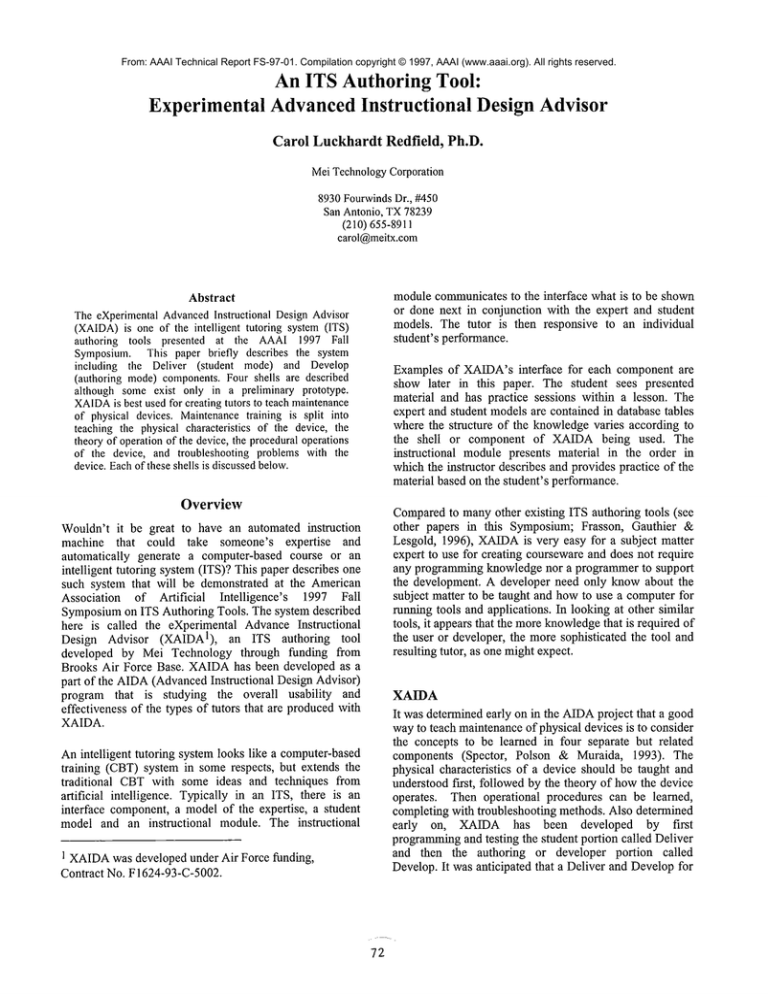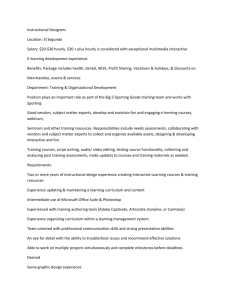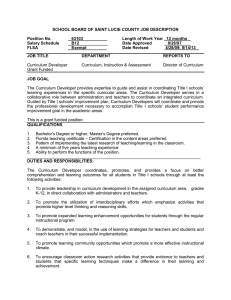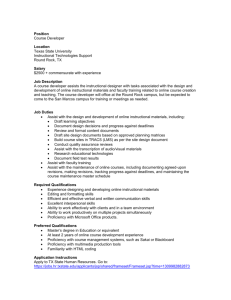
From: AAAI Technical Report FS-97-01. Compilation copyright © 1997, AAAI (www.aaai.org). All rights reserved.
An ITS Authoring Tool:
Experimental Advanced Instructional Design Advisor
Carol LuckhardtRedfield, Ph.D.
MeiTechnologyCorporation
8930FourwindsDr., #450
San Antonio, TX78239
(210) 655-8911
carol@meitx.com
modulecommunicatesto the interface what is to be shown
or done next in conjunction with the expert and student
models. The tutor is then responsive to an individual
student’s performance.
Abstract
The experimental AdvancedInstructional Design Advisor
(XAIDA)
is one of the intelligent tutoring system(ITS)
authoring tools presented at the AAAI1997 Fall
Symposium.This paper briefly describes the system
including the Deliver (student mode) and Develop
(authoring mode)components.Four shells are described
although someexist only in a preliminary prototype.
XAIDA
is best used for creating tutors to teach maintenance
of physical devices. Maintenancetraining is split into
teaching the physical characteristics of the device, the
theoryof operationof the device, the proceduraloperations
of the device, and troubleshooting problems with the
device.Eachof these shells is discussedbelow.
Examples of XAIDA’sinterface for each component are
show later in this paper. The student sees presented
material and has practice sessions within a lesson. The
expert and student modelsare contained in database tables
where the structure of the knowledgevaries according to
the shell or component of XAIDAbeing used. The
instructional module presents material in the order in
which the instructor describes and provides practice of the
material based on the student’s performance.
Overview
Comparedto manyother existing ITS authoring tools (see
other papers in this Symposium; Frasson, Gauthier &
Lesgold, 1996), IDAis very easy for a subject matter
expert to use for creating coursewareand does not require
any programmingknowledge nor a programmer to support
the development. A developer need only know about the
subject matter to be taught and howto use a computerfor
running tools and applications. In looking at other similar
tools, it appears that the moreknowledgethat is required of
the user or developer, the moresophisticated the tool and
resulting tutor, as one mightexpect.
Wouldn’t it be great to have an automated instruction
machine that could take someone’s expertise
and
automatically generate a computer-based course or an
intelligent tutoring system(ITS)? This paper describes one
such system that will be demonstrated at the American
Association of Artificial
Intelligence’s
1997 Fall
Symposiumon ITS Authoring Tools. The system described
here is called the eXperimental Advance Instructional
Design Advisor (XAIDAI), an ITS authoring tool
developed by Mei Technology through funding from
Brooks Air Force Base. XAIDA
has been developed as a
part of the AIDA(AdvancedInstructional Design Advisor)
program that is studying the overall usability and
effectiveness of the types of tutors that are producedwith
XAIDA.
XAIDA
It was determined early on in the AIDAproject that a good
wayto teach maintenanceof physical devices is to consider
the concepts to be learned in four separate but related
components (Spector, Polson & Muraida, 1993). The
physical characteristics of a device should be taught and
understood first, followed by the theory of howthe device
operates. Then operational procedures can be learned,
completing with troubleshooting methods. Also determined
early on, XAIDA has been developed
by fu~t
programmingand testing the student portion called Deliver
and then the authoring or developer portion called
Develop. It was anticipated that a Deliver and Developfor
Anintelligent tutoring system looks like a computer-based
training (CBT) system in some respects, but extends the
traditional
CBTwith some ideas and techniques from
artificial intelligence. Typically in an ITS, there is an
interface component,a model of the expertise, a student
model and an instructional
module. The instructional
1 XAIDA
was developed under Air Force funding,
Contract No. F 1624-93-C-5002.
72
each of the four shells wouldbe developed. Althoughtwo
shells have been completed, the other two exist as a
combination of prototypes and design documents.
Basically a developer sitting at an XAIDA
interface inputs
expertise about a device or topic, filling in templates and
using various XAIDAeditors.
With the information
provided by the developer, XAIDA
produces an intelligent
tutoring system that teaches that expertise.
The
effectiveness of these lessons has been shownin numerous
studies, and lessons of manyand varied topics have been
developed, including ones that were not intended to be the
type produced by XAIDAsuch as customer satisfaction
and parabolic equations (Wenzel, Halff, Richardson,
Gibson, 1996).
The following sections describe the current componentsof
XAIDAincluding Deliver and Develop for Physical
Characteristics,
Deliver and Develop for Theory of
Operation, Deliver for Procedures, and Deliver for
Troubleshooting. The Developportions of each shell have
been designed to be a what-you-see-is-what-you-get
interface, so the Deliver portion shows what Develop
would look like with someadditional menuoptions, tool
bars, and editors.
73
it. The student is asked questions about the location of
parts, the part hierarchy, and facts about parts. This
practice is doneafter each set of subparts.
Physical
Characteristics
Deliver of Physical Characteristics for a coffee makeris
shown below. The student can use the Next and Back
buttons to navigate or select an item in the Contents or
Outline windows. The student can also click on a part
inside the Portrayal windowand go the portion of the
lesson on that selected part.
Both Deliver and Develop are fully operational for this
component.The physical attributes and characteristics of a
device are easily and quickly input into the Develop
component.The data is stored as a tree structure of parts of
the device with media and facts attached to each part as
needed. The developer must provide a picture or
backgroundgraphic for each part that has parts underneath
Co[[ee Machine
!_F de 6oTo Help
+~Switch
-- Reselvoir
-- Filler
Basket
Coffee
Pot
Filter Basket
Coffee Machine
Coffee
Video
Coffee
Pot
I~
Parts
:1 . :~
Thecapacityof the CoffeeMachine
is 2 to 12 cups.
PressNextto viewParts.
Back
74
the developer,andthe student can manipulatethe valuesin
what is called a user-defined case. The learns the
interactions andrelationshipsof the operationsof a device
by studyingthese cases andassociatedrules.
Theory of Operation
The theory of howa device worksand operates is taught
with a theory of operation lesson. This componentalso
exists in a fully developedDeliverandDevelopform.
The knowledgefor the Theoryof Operationis stored as
rules of howthe valuesof variablesor attributes relate with
specified cases. Thestudent sees the cases determinedby
Onescreen of Deliver of a Theoryof Operationlesson on
an ejection seat in an Air Forceaircraft is shownbelow.
i ld°’°°h°dI
~J
]i
i
H
I u,,od
el j
~ Start of the EiectionSequence
~ -~ Activated Position
-~ DetachedPosition
;_
",; ~’i::;:,-;:,>:..-, ¯ ....,-.:. :..<,.:..~.,....;.~.,~;.,
:,:-.-,.. ............. :,.-.,,.,: -
Theeiection
initiatorsactivate
therocketcatapult
that
propells
theseatoutof theaircraft.
__
_
__
75
_
~ ~ > .....
~.
~_
student’s goal is to perform the entire procedurecorrectly.
Practicing a step consists of selecting an object, an action,
and an optional tool. Potentially a simulation can be put in
place of this simplistic functional simulation.
Procedures
Procedures are represented as a series of steps with
associated information such as pictures, mistakes, tools,
mishaps, notes, warnings and cautions. A developer inputs
the correct steps in addition to typical or common
problems that arise in performing the procedures, both
those caused by the user and those resulting from outside
forces. A lesson consists of presenting and practicing the
steps of the procedure and answering questions. The
I~o cedu~,e OuePuie~
Descli~on
Equations
ViewProcedure
Lesson Conl;¢nl;~
inlroduction
ProcedureOwrview
1. drawa picture
2. set up variables
3. find equations
4. solve the equation
5. answerthe question
PotentialProblems
Currently, the Deliver portion of Proceduresis in prototype
form and the Developportion is only partially designed on
paper. Below is an example of the Deliver portion of
Procedures.
Find the length of the side of a square
that has a perimeter of 24 em.
formula for perimeter
of a square is
P = 4s where s is
the length of the side
24 cm
s = length of the side
24 cm = 4s
4s = 24 cm
4s/4 = 24/4 cm
S
The length of the side is
GO TO
76
=
6cm
(6era)
= Equations
student isolates and repairs single faults. Adviceand error
correction is provided immediately based on the student’s
actions.
Troubleshooting
This troubleshooting shell exists as a very primitive
prototype where a database can be manually entered to be
presented as a lesson to students. The Develop component
has not been fully defined.
The Troubleshooting shell teaches a student how to do
fault isolation. The knowledgeof the expert is stored as a
fault tree and howto traverse that tree. The instructional
module presents new and previously seen faults as a
student progresses through a troubleshooting lesson. A
student moves between viewing the Service Order,
Troubleshooting Guide, and Stopgap Simulation. The
The office network is a peer to peer network based on Microsoft Windows3.1 1 that
Provides file sharing, file transfer, and print sharing.
I
i Submodules
System
Service Order
Resolution
for NoStart
elimination, the Office
Networkis faulted
Sewerstarts successfully.
77
Conclusions
XAIDA
has proven to be effective at quick developmentof
useful ITS material. Manysubject matter experts have used
the systemand been surprised at howfast they can develop
lessons. In manycases, finding and putting together the
~aphics and other media such as sound, video, and
animation takes up muchof the time in creating a course.
Organizingand inputting the content required is
accomplishedin a short period of time especially compared
to current method of CBTand ITS development. Many
courses have been developedin a matter of a few hours
(Walsh, 1994).
References
Frasson, C., Gauthier, G., & Lesgold, A. (Eds.). 1996.
Intelligent
Tutoring Systems: Third International
ConferenceProceedings. ITS ’96. Berlin: Springer-Verlag.
Spector, J.M., Polson, M.C., & Muraida, D.J. (Eds.) t993.
Automating Instructional Design: Concepts and Issues.
Englewood Cliffs,
N J: Educational
Technology
Publications.
Walsh, W.J. 1994. Automated Authoring:
Some
Preliminary Results, 16th Interservice/ Industry Training
Systems and Education Conference, Orlando, FL
Wenzel, B.M., Halff, H.M., Richardson, K., and Gibson,
E.G. November, 1996. Assessing the instructional
effectiveness of the Experimental AdvancedInstructional
Advisor (XAIDA).Interim technical report for U.S. Air
Force Armstrong Laboratory.
78





